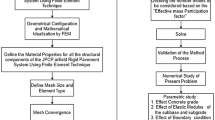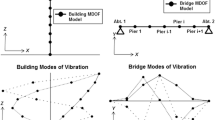Abstract
Objective
In the present study, the deflections governed by cyclic strength due to structural vibrations caused by high-velocity moving load on a rigid pavement have been evaluated.
Methods
A novel finite-element-based cyclic response model has been proposed in terms of velocity-induced stress ratio for the design of rigid pavement. It consists of a characteristic strength and the number of cycles of moving load. The central deflection of the rigid pavement is captured for varied loading inputs, velocities, and pavement thicknesses.
Results
The velocity-induced deflection zones have been identified for a set of selected velocities. A set of displacement contours have been observed along with a displacement shift and phase transformation in principal stress fields beyond a critical value. The vibrational compounded stress transfer mechanism (V-CSTM) for rigid pavement design has been presented using the thickness of the pavement, velocity, and intensity of the moving load. The results have been compared within the output obtained from numerically varied parameters utilizing codal provisions. The cyclic strength of the rigid pavement has been found as 0.01-0.2% of the characteristic strength. The findings imply that the rigid pavement will withstand 1015–109 cycles of moving load within the range of input parameters.
Societal benefits
The research outcomes provide a classified interpretation for the field engineers and practitioners to evaluate the life of rigid pavement supported by granular bases for construction practices.












Similar content being viewed by others
Data Availability
All data used are appended (available in the supplementary data section) or included in the submitted article.
Abbreviations
- \({\varepsilon }_{p}\) :
-
accumulated permanent strain
- \({\varepsilon }_{r}\) :
-
rebound strain
- N :
-
loading repetition
- \({\varepsilon }_{pn}\) :
-
permanent strain after N loading cycle
- \({\varepsilon }_{r} \left(1\right)\) :
-
rebound strain after one loading cycle
- \({f}_{ ck}\) :
-
characteristic strength of pavement material
- \({\sigma }^{tr}\) :
-
trial stress
- \(G\) :
-
shear modulus
- \({S}_{r}\) :
-
stress ratio
- \(v\) :
-
the velocity of the moving load
- \(\mu \), \(\alpha \), \(S\), a, b, p :
-
empirical parameters
- [M]:
-
mass matrix
- [C]:
-
damper matrix
- [K]:
-
stiffness matrix
- {ẍ}:
-
acceleration vector
- {ẋ}:
-
velocity vector
- {x}:
-
displacement vector
- {FE}:
-
externally prescribed force vector
- \(\left\{{\text{Q}}_{\text{B}}\right\}\) :
-
body force in terms of elemental volume
- \(\left\{{\text{Q}}_{\text{I}}\right\}\) :
-
inertial force in terms of elemental volume
- {QE}:
-
externally prescribed force in terms of elemental volume
- \({\text{N}}_{\text{i}}^{\text{N}}\) :
-
shape function
- \(\vartheta _{\alpha }^{I}\) :
-
hourglass base vectors
- \({\text{W}}_{\text{B}}\) :
-
work done by body force
- \({\text{W}}_{\text{I}}\) :
-
work done by inertial force
- \({\text{W}}_{\text{E}}\) :
-
work done by externally prescribed force
- \({\text{M}}_{\text{C}}^{\text{NM}}\) :
-
mass matrices obtained by consistent use of interpolation
- \( I_{N}^{F} \) :
-
inertial force vector
- \({\text{Q}}_{\text{F}}^{\text{N}}\) :
-
external force vector
- \( \Phi ,\psi \,{\text{and}}\,\Gamma \) :
-
free parameters possessing the characteristics of damping
- D:
-
time-dependent damping factor (DF) matrix
References
Bourdeau PL, Ashmawy AK, Trivedi A, Shukla SK (2021) Unpaved roads. ICE handbook of geosynthetic engineering geosynthetics and their applications. ICE Publishing, London
Singh M, Trivedi A, Shukla SK (2020) Unpaved test sections reinforced with geotextile and geogrid. Mater Today 32:706–711. https://doi.org/10.1016/j.matpr.2020.03.260
Singh M, Trivedi A, Shukla SK (2020) Fuzzy-based model for predicting strength of geogrid-reinforced subgrade soil with optimal depth of geogrid reinforcement. Transport Infrastr Geotechnol 7(4):664–683. https://doi.org/10.1007/s40515-020-00113-y
Singh M, Trivedi A, Shukla SK (2019) Strength enhancement of the subgrade soil of unpaved road with geosynthetic reinforcement layers. Transportat Geotech 19:54–60. https://doi.org/10.1016/j.trgeo.2019.01.007
Kumar Y, Trivedi A, Shukla SK (2023) Damage evaluation in pavement geomaterial system using finite element scaled accelerated pavement testing. Transportat Infrastruc Geotechnol. https://doi.org/10.1007/s40515-023-00309-y
Rajasekaran S, Khaniki HB (2019) Size-dependent forced vibration of non-uniform bi-directional functionally graded beams embedded in variable elastic environment carrying a moving harmonic mass. Appl Math Model 72:129–154. https://doi.org/10.1016/j.apm.2019.03.021
Hashemi SH, Khaniki HB (2018) Dynamic response of multiple nanobeam system under a moving nanoparticle. Alex Eng J 57(1):343–356. https://doi.org/10.1016/j.aej.2016.12.015
Hosseini-Hashemi S, Khaniki HB (2018) Three dimensional dynamic response of functionally graded nanoplates under a moving load. Struct Eng Mech 66(2):249–262. https://doi.org/10.12989/sem.2018.66.2.249
Hashemi SH, Khaniki HB (2017) Dynamic behavior of multi-layered viscoelastic nanobeam system embedded in a viscoelastic medium with a moving nanoparticle. J Mech 33(5):559–575. https://doi.org/10.1017/jmech.2016.91
Vu HT, Le TC, Nguyen-Xuan H, Abdel Wahab M (2022) Polygonal finite element for two-dimensional lid-driven cavity flow. Cmc-Comput Mater Continua 70(3):4217–4239. https://doi.org/10.32604/cmc.2022.020889
Tran-Ngoc H, Khatir S, Le-Xuan T, De Roeck G, Bui-Tien T, Abdel Wahab M (2021) Finite element model updating of a multi-span bridge with a hybrid metaheuristic search algorithm using experimental data from wireless triaxial sensors. Eng Comput. https://doi.org/10.1007/s00366-021-01307-9
Ling Y, Ni J, Antonissen J, Hamouda HB, Voorde JV, Wahab MA (2023) Numerical prediction of microstructure and hardness for low carbon steel wire arc additive manufacturing components. Simulat Modell Pract Theory 122:102664. https://doi.org/10.1016/j.simpat.2022.102664
Nguyen KD, Thanh CL, Vogel F, Nguyen-Xuan H, Abdel-Wahab M (2022) Crack propagation in quasi-brittle materials by fourth-order phase-field cohesive zone model. Theoret Appl Fract Mech 118:103236. https://doi.org/10.48550/arXiv.2212.07036
Lewis KH, Harr M (1969) Analysis of concrete slabs on ground subjected to warping and moving loads. Highway Res Rec 291(17):194–211
Taheri MR, Ting EC (1990) Dynamic response of plates to moving loads: finite element method. Comput Struct 34(3):509–521. https://doi.org/10.1016/0045-7949(90)90276-8
Burmister DM (1945) The general theory of stresses and displacements in layered soil systems-II. J Appl Phys. https://doi.org/10.1063/11707562
Burmister DM (1945) The general theory of stresses and displacements in layered soil systems-III. J Appl Phys. https://doi.org/10.1063/11707590
Burmister DM (1945) The general theory of stresses and displacements in layered systems-I. J Appl Phys. https://doi.org/10.1063/11707558
Chen WT (1971) Computation of stresses and displacements in a layered elastic medium. Int J Eng Sci. https://doi.org/10.1016/0020-7225(71)90072-3
Hoskin BC, Lee EH (1959) Flexible surfaces on viscoelastic subgrades. J Eng Mech Divis. https://doi.org/10.1061/jmcea3.0000101
Achenbach JD, Sun CT (1965) Moving load on a flexibly supported Timoshenko beam. Int J Solids Struct 1(4):353–370. https://doi.org/10.1016/0020-7683(65)90001-6
Taheri MR, Ting EC (1989) Dynamic response of plate to moving loads: structural impedance method. Comput Struct. https://doi.org/10.1016/0045-7949(89)90478-1
Wu CP, Shen PA (1996) Dynamic analysis of concrete pavements subjected to moving loads. J Transportat Eng. https://doi.org/10.1061/(ASCE)0733-947X(1996)122:5(367)
Wang B, Yang J (2008) Effects of vehicle dynamic loading on CRCP by 3D finite element method. J Southeast Univ 38(5):850–855
Yang S, Li S, Lu Y (2010) Investigation on dynamical interaction between a heavy vehicle and road pavement. Vehicle Syst Dynam. https://doi.org/10.1080/00423110903243166
Eberle R, Oberguggenberger M (2022) Vibrations of a bridge with random structural irregularities under random traffic load and a probabilistic structural degradation assessment approach. J Vibrat Eng Technol. https://doi.org/10.1007/s42417-022-00675-w
Ding H, Yang Y, Chen LQ, Yang SP (2014) Vibration of vehicle-pavement coupled system based on a Timoshenko beam on a nonlinear foundation. J Sound Vibrat. https://doi.org/10.1016/j.jsv.2014.07.016
Lu Z, Fang R, Yao H, Dong C, Xian S (2018) Dynamic responses of unsaturated half-space soil to a moving harmonic rectangular load. Int J Num Analyt Methods Geomech. https://doi.org/10.1002/nag.2780
Kumar Y (2020) Dynamic Analysis of Constrained Rigid Pavement Subjected to Moving Load. M. Tech dissertation, Delhi Technological University, Delhi, India.
Singh M, Trivedi A, Shukla SK (2022) Evaluation of geosynthetic reinforcement in unpaved road using moving wheel load test. Geotext Geomemb. https://doi.org/10.1016/j.geotexmem.2022.02.005
Tang C, Lu Z, Duan Y, Yao H (2020) Dynamic responses of the pavement-unsaturated poroelastic ground system to a moving traffic load. Transportat Geotech 25:1–8. https://doi.org/10.1016/j.trgeo.2020.100404
Zhao Y, Jiang L, Zhou L (2015) Ambient Temperature and Vehicle Loading Effects on Asphalt Concrete Pavement Rutting Development. In: ICTE 2015 Proceedings of the 5th International Conference on Transportation Engineering. Doi: https://doi.org/10.1061/9780784479384.136
Teng XQ, Li XZ, Chou K (2008) Application of finite element analysis to access the rutting potential in asphalt pavements. Transportation and Development Innovative Best Practices 2008 - Proceedings of the 1st International Symposium on Transportation and Development Innovative Best Practices 319. Doi: https://doi.org/10.1061/40961(319)79
Yao Z, Zhou L, Shang Q, Guo J, Wang N (2012) Analysis of rutting change rule on asphalt pavement overlay. Adv Mater Res. https://doi.org/10.4028/www.scientific.net/AMR.368-373.3131
Pirabarooban S, Zaman M, Tarefder RA (2003) Evaluation of rutting potential in asphalt mixes using finite element modeling. In: TAC/ATC Annual Conference and Exhibition of the Transportation Association of Canada: The Transportation Factor.
Li S, Guo Z, Yang Y (2015) Rutting Resistance Ability Analysis of Heavy Duty Asphalt Pavements Based on Consecutive Temperature Variation and Finite Element Method. In: CICTP 2015 - Efficient, Safe, and Green Multimodal Transportation - Proceedings of the 15th COTA International Conference of Transportation Professionals. Doi: https://doi.org/10.1061/9780784479292.094
Hua J, White TA (2002) Study of nonlinear tire contact pressure effects on HMA rutting. Int J Geomech. https://doi.org/10.1061/(asce)1532-3641(2002)2:3(353)
Cao P, Feng DC, Jing RX (2012) Based on FE method to research resistant rutting ability of pavement structure in Heilongjiang province. Appl Mech Mater. https://doi.org/10.4028/www.scientific.net/AMM.128-129.1349
Imaninasab R, Bakhshi B, Shirini B (2016) Rutting performance of rubberized porous asphalt using finite element method (FEM). Construct Build Mater. https://doi.org/10.1016/j.conbuildmat.2015.12.134
Boverkets handbok om betongkonstruktioner, BBK 04 (English) (2004) Boverkets handbok om betongkonstruktioner. Boverket, Sweden
Eurocode 2, EC2 (English) (2004) Design of concrete structures - Part 1–1: General rules and rules for buildings. Federal Region of Belgium, Brussels
Congress IR, IRC 58 (2015) Guidelines for the Design of Plain Jointed Rigid Pavements for Highways. Delhi, India
Tong LH, Zeng L, Geng DX, Hu W, Xu CJ (2020) Dynamic effect of a moving ring load on a cylindrical structure embedded in poroelastic space based on nonlocal Biot theory. Soil Dyn Earthq Eng 128:1–9. https://doi.org/10.1016/j.compgeo.2021.104118
Monismith CL, Ogawa N, Freeme CR (1975) Permanent deformation characteristics of subgrade soils due to repeated loading. Transportation research record 537.
Federal Highway Administration, VESYS (1977) User’s manual: predictive design procedures. California, USA
Barksdale RD (1972) Laboratory evaluation of rutting in base course materials. Int Conf Struct Design Asphalt Pavements 1:11–15
Lytton RL, Uzan J, Fernando EG, Roque R, Hiltunen D, Stoffels SM (1993) Development and validation of performance prediction models and specifications for asphalt binders and paving mixes. Strategic Highway Research Program, Washington, DC
Tseng KH, Lytton RL (1989) Prediction of permanent deformation in flexible pavement materials. Implicat Aggregat Design, Construct Perform Flexible Pavements 1016:154–172
American Association of State Highway and Transportation Officials, AASHTO (2002) Guide for pavement design of pavement structures. Washington D.C, USA
ABAQUS Inc (2017) ABAQUS version 2017: Analysis User’s Manual.
American Concrete Institute ACI 318-14 (2015) Building code requirements for structural concrete and commentary. Farmington Hills, USA
Wang YS, Fu CG (2010) ABAQUS structural engineering analysis and example explanation. China Architecture and Building Press, Beijing, China
Yang S, Lu Y, Li S (2013) An overview on vehicle dynamics. Int J Dynam Control 1(4):385–395. https://doi.org/10.1007/s40435-013-0032-y
Hilber HM, Hughes TJR, Taylor RL (1977) Improved numerical dissipation for time integration algorithms in structural dynamics. Earthquake Eng Struct Dynam 5(3):283–292. https://doi.org/10.1002/eqe.4290050306
Acknowledgements
The financial support received under the research project grant [F. No. DTU/IRD/619/2105] of Delhi Technological University, Delhi, and the availability of a workstation with ABAQUS from the mechanical engineering department, Delhi Technological University, Delhi, is thankfully acknowledged. The authors also acknowledge Mrs. Sheetal (TGT), Kendriya Vidhyalya-II, Pathankot, Punjab for proofreading and pointing out some crucial grammar and sentence structure.
Author information
Authors and Affiliations
Corresponding author
Ethics declarations
Conflict of Interest
All authors mentioned in the manuscript declare no conflict of interest.
Additional information
Publisher's Note
Springer Nature remains neutral with regard to jurisdictional claims in published maps and institutional affiliations.
Supplementary Information
Below is the link to the electronic supplementary material.
Rights and permissions
Springer Nature or its licensor (e.g. a society or other partner) holds exclusive rights to this article under a publishing agreement with the author(s) or other rightsholder(s); author self-archiving of the accepted manuscript version of this article is solely governed by the terms of such publishing agreement and applicable law.
About this article
Cite this article
Kumar, Y., Trivedi, A. & Shukla, S.K. Deflections Governed by the Cyclic Strength of Rigid Pavement Subjected to Structural Vibration Due to High-Velocity Moving Loads. J. Vib. Eng. Technol. 12, 3543–3562 (2024). https://doi.org/10.1007/s42417-023-01063-8
Received:
Revised:
Accepted:
Published:
Issue Date:
DOI: https://doi.org/10.1007/s42417-023-01063-8




